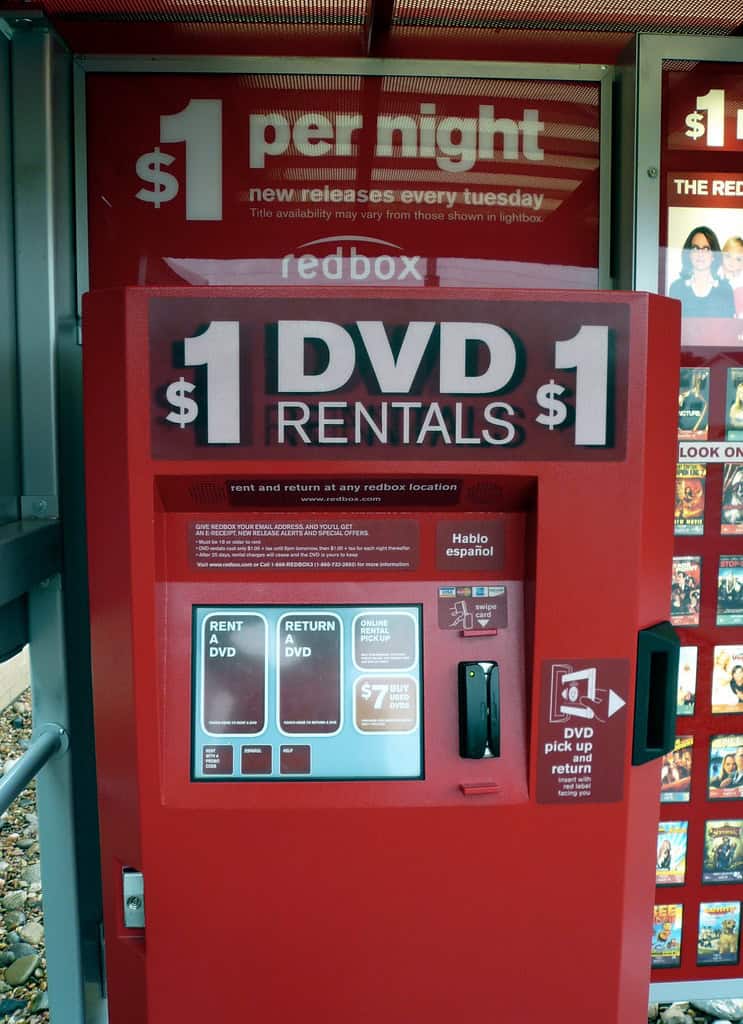
Redbox, once a familiar sight at grocery stores and shopping centers, has come to an end. The DVD rental company known for its bright red kiosks has shut down operations due to bankruptcy. Redbox’s parent company, Chicken Soup for the Soul Entertainment, filed for Chapter 7 bankruptcy with nearly $1 billion in debt.
The company faced tough times in recent years as more people turned to streaming services, fewer rented DVDs. Redbox tried to adapt by offering its own streaming service, but it couldn’t keep up with big players like Netflix and Disney+.
With the closure, Redbox will remove its 24,000 kiosks from locations across the country and about 1,000 employees will lose their jobs. Customers who bought digital movies through Redbox may lose access to their purchases.
Image Credit: Flikr
The Decline of Redbox: From DVD King to Streaming Casualty
The Rise of Redbox
Redbox was once a dominant force in home entertainment. Founded in 2002, the company capitalized on the growing popularity of DVDs. Its kiosks offered a convenient and affordable way to rent movies, popping up everywhere from grocery stores to fast-food restaurants. At its peak, Redbox operated over 40,000 kiosks across the United States.
The Shift to Streaming
The rise of streaming services like Netflix and Hulu gradually eroded Redbox’s market share. Consumers embraced the instant access and vast libraries offered by these platforms. Redbox attempted to adapt by launching its own streaming service and adding video games to its kiosks, but these efforts failed to stem the decline.
Acquisition and Financial Troubles
In 2022, Redbox was acquired by Chicken Soup for the Soul Entertainment. However, the company continued to struggle financially. It faced challenges in securing new movie releases and maintaining its aging kiosk network.
The End of an Era
In late 2023, Redbox officially shut down its remaining kiosks and discontinued its DVD rental business. The company now focuses solely on its streaming service, Redbox On Demand, which offers a mix of free and paid content.
Factors Contributing to Redbox’s Demise
Several factors contributed to Redbox’s downfall:
- The rise of streaming: Streaming services offered greater convenience and selection.
- Changing consumer habits: People increasingly preferred digital content over physical media.
- Competition: Redbox faced competition not only from streaming giants but also from other kiosk providers like Coinstar.
- Financial difficulties: The company struggled with debt and declining revenue.
Redbox’s Legacy
Despite its demise, Redbox played a significant role in the evolution of home entertainment. It provided an affordable and accessible way for millions to enjoy movies. The company’s red kiosks became a familiar sight in American communities, a symbol of a bygone era in movie rental history.
Timeline of Key Events
| Year | Event |
|---|---|
| 2002 | Redbox is founded. |
| 2008 | Redbox reaches 10,000 kiosks. |
| 2012 | Redbox launches its streaming service. |
| 2022 | Redbox is acquired by Chicken Soup for the Soul Entertainment. |
| 2023 | Redbox shuts down its kiosks and ends its DVD rental business. |
Key Takeaways
- Redbox has closed due to bankruptcy after 22 years in business
- The company struggled to compete with streaming services
- Redbox will remove its kiosks and lay off employees
The Evolution of Redbox
Redbox changed a lot since it started. It grew fast and tried new things as people’s movie habits changed.
Origins and Expansion
Redbox began in 2002. McDonald’s started it to rent DVDs in fast food spots. The bright red kiosks were easy to spot. In 2005, Coinstar bought part of Redbox. This helped it grow even more.
Redbox kiosks popped up in many places. You could find them at grocery stores and drug stores. People liked the low prices and new movies. By 2017, Redbox had over 40,000 kiosks in the U.S.
Galen Smith became CEO in 2016. He led Redbox as part of Outerwall. The company kept growing for a while.
Shift to Digital
As Netflix got bigger, Redbox had to change. People started to watch more movies online. Redbox tried to keep up with this trend.
In 2017, they launched Redbox On Demand. This let people rent or buy movies online. They also started a free streaming service with ads.
But it was hard to compete with big streaming companies. Redbox struggled to keep customers as more people switched to streaming. They tried different things, but it wasn’t enough.
Financial and Strategic Developments
Redbox faced major changes in its business model and ownership. The company made big moves to stay competitive in the streaming age.
Acquisitions and Partnerships
Redbox joined with Seaport Global Acquisition Corp in 2021. This deal made Redbox a publicly traded company. It traded on Nasdaq under the symbol RDBX.
In 2022, Chicken Soup for the Soul Entertainment bought Redbox. This all-stock deal was worth $375 million. It gave Redbox owners 23.5% of the new company.
Redbox tried to grow its digital business. It teamed up with Crackle to offer more streaming options.
Market Performance and Investor Relations
Redbox struggled with debt and low income. By 2023, it owed over $1 billion. The company filed for bankruptcy in June 2023.
Before that, Redbox’s stock price dropped a lot. Investors lost faith in its future. The firm couldn’t keep up with big streaming services.
Redbox aimed for $40 million in cost savings after merging with Chicken Soup for the Soul. But its finances kept getting worse. The bankruptcy filing was the last step in Redbox’s decline.
Frequently Asked Questions
Redbox has faced major changes in recent years. Its business model and services have shifted due to market forces and new tech.
What led to the decline in Redbox kiosks?
The rise of streaming hurt Redbox. People now watch movies online instead of renting DVDs. This cut Redbox’s income a lot. From 2019 to 2021, yearly sales dropped from $829 million to $289 million.
COVID-19 also hit Redbox hard. Fewer people went out to rent movies during lockdowns.
Has there been a reduction in the number of Redbox locations?
Yes, Redbox has closed many kiosks. The exact number is not clear. But the company has shrunk its network of rental spots over time.
This matches the drop in DVD rentals. As demand fell, Redbox cut back on kiosks to save money.
What changes have occurred in the Redbox business model?
Redbox tried to add digital rentals and streaming. They made an app for renting and buying digital movies. But this move came late, after other streaming services got big.
The company also bought a streaming platform called Popcornflix. This was part of a plan to shift away from physical rentals.
How has the transition to digital affected Redbox operations?
The shift to digital hurt Redbox’s main business of DVD rentals. They couldn’t keep up with big streaming firms like Netflix.
Redbox’s try at digital services didn’t work well. Their app and streaming efforts didn’t gain enough users to make up for lost DVD rentals.
Are there any new developments in Redbox’s services or offerings?
Sadly, Redbox is closing down. The company filed for bankruptcy in 2024. They are selling off their assets.
This means no new services are coming. Instead, Redbox is ending its business after 22 years.
What is the current state of Redbox’s physical media rental service?
Redbox’s DVD rental service is ending. The company filed for Chapter 7 bankruptcy. This means they are closing for good.
Kiosks are being removed. Customers can’t rent or return DVDs anymore. The physical rental service that Redbox was known for is now over.






